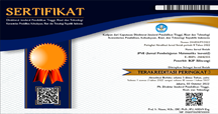Analisis semiotik: representamen siswa dalam menyelesaikan operasi bilangan bulat
DOI:
https://doi.org/10.22460/jpmi.v6i4.17860Keywords:
Integers, Representamen, SemioticsAbstract
The purpose of this research is to investigate and describe student representation in solving integer operations. The research method used is descriptive qualitative research method. The subjects in this study were 15 of 31 junior high school students. Each of them is 9 Iconic Subjects (SI), namely subjects whose settlements use Iconic Representations and 6 Symbolic Subjects (SS), namely subjects whose settlements use Symbolic Representations. This study found that there are two types of Representamen in students' semiotic processes in solving Integer problems, namely types of iconic Representamen and symbolic Representamen. Iconic representation types are sign types that have a similar relationship with the object they represent, while symbolic representation types have a convention or rule relationship with the object they represent.
References
Alshwaikh, J. (2010). Geometrical diagrams as representation and communication: A functional analytic framework. Research in Mathematics Education, 12(1). https://doi.org/10.1080/14794800903569881
Bishop, J. P., Lisa, L. L., Randolph, A. P., Lan, W., Bonnie, P. S., & Melinda, L. L. (2014). Obstacles and affordances for integer reasoning: An analysis of children’s thinking and the history of mathematics. Journal for Research in Mathematics Education, 45(1), 19–61. https://doi.org/10.5951/jresematheduc.45.1.0019
Bofferding, L. (2012). Transitioning from whole numbers to integers. North American Chapter of the International Group for the Psychology of Mathematics Education.
Bofferding, L. (2014). Negative integer understanding: Characterizing first graders’ mental models. Journal for Research in Mathematics Education, 45(2), 194–245. https://doi.org/10.5951/jresematheduc.45.2.0194
Bofferding, L., Hoffman, A., Suazo, E., & Lisy, N. (2015). Number line estimation with negatives. Proceedings of the 37th Annual Meeting of the North American Chapter of the International Group for the Psychology of Mathematics Education., 133–140.
Bofferding, L., & Wessman-Enzinger, N. (2017). Subtraction involving negative numbers: Connecting to whole number reasoning. Mathematics Enthusiast, 14(1–3), 241–262.
Bossé, M., Lynch-Davis, K., Adu-Gyamfi, K., & Chandler, K. (2016). Using integer manipulatives: representational determinism. International Journal for Mathematics Teaching and Learning, 17(3).
Daher, W. M. (2014). Manipulatives and problem situations as escalators for students’ geometric understanding: a semiotic analysis. International Journal of Mathematical Education in Science and Technology, 45(3). https://doi.org/10.1080/0020739X.2013.837527
Eichhorn, M. S., Perry, L. E., & Brombacher, A. (2018). Students’ early grade understanding of the equal sign and non-standard equations in Jordan and India. International Journal of Research in Education and Science, 4(2), 655–669. https://doi.org/10.21890/ijres.432520
Khalid, M., & Embong, Z. (2019). Sources and possible causes of errors and misconceptions in operations of integers. International Electronic Journal of Mathematics Education, 15(2), em0568.
Kurniati, D., & As’ ari, A. R. (2018). Exploring the mental structure and mechanism: how the style of truth-seekers in mathematical problem-solving?. Journal on Mathematics Education, 9(2), 311–326.
Miller, J. (2015). Young indigenous students’ engagement with growing pattern tasks: a semiotic perspective. Mathematics Education Research Group of Australasia.
Mudaly, V. (2014). A visualisation-based semiotic analysis of learners’ conceptual understanding of graphical functional relationships. African Journal of Research in Mathematics, Science and Technology Education, 18(1), 3–13. https://doi.org/10.1080/10288457.2014.889789
Palayukan, H., & Purwanto, S. (2022). Semiotics in integers: how can the semiosis connections occur in problem solving? Webology, 19(2), 98–111.
Palayukan, H., Purwanto, Subanji, & Sisworo. (2020). Student’s semiotics in solving problems geometric diagram viewed from peirce perspective. AIP Conference Proceedings, 2215, 060020. https://doi.org/10.1063/5.0000719
Presmeg, N., Radford, L., Roth, W.-M., & Kadunz, G. (2016). Semiotics in mathematics education ICME-13 Topical Surveys. http://www.springer.com/series/14352
Schindler, M., Hußmann, S., Nilsson, P., & Bakker, A. (2017). Sixth-grade students’ reasoning on the order relation of integers as influenced by prior experience: an inferentialist analysis. Mathematics Education Research Journal, 29(4), 471–492. https://doi.org/10.1007/s13394-017-0202-x
Subanji, S., & Nusantara, T. (2016). Thinking process of pseudo construction in mathematics concepts. International Education Studies, 9(2), 17. https://doi.org/10.5539/ies.v9n2p17
Teppo, A., & van den Heuvel-Panhuizen, M. (2014). Visual representations as objects of analysis: The number line as an example. ZDM - International Journal on Mathematics Education, 46(1), 45–58. https://doi.org/10.1007/s11858-013-0518-2
Vlassis, J. (2008). The role of mathematical symbols in the development of number conceptualization: The case of the minus sign. Philosophical Psychology, 21(4), 555–570. https://doi.org/10.1080/09515080802285552
Yilmaz, A., Akyuz, D., & Stephan, M. (2019). Middle grade students’ evoked concept images of number line models and their calculation strategies with integers using these models. International Journal of Education in Mathematics, Science and Technology, 7(1), 93–115. https://doi.org/10.18404/ijemst.509292.
Downloads
Published
Issue
Section
License
Copyright (c) 2023 JPMI (Jurnal Pembelajaran Matematika Inovatif)

This work is licensed under a Creative Commons Attribution-ShareAlike 4.0 International License.
The author is responsible for acquiring the permission(s) to reproduce any copyrighted figures, tables, data, or text that are being used in the submitted paper. Authors should note that text quotations of more than 250 words from a published or copyrighted work will require grant of permission from the original publisher to reprint. The written permission letter(s) must be submitted together with the manuscript.
















